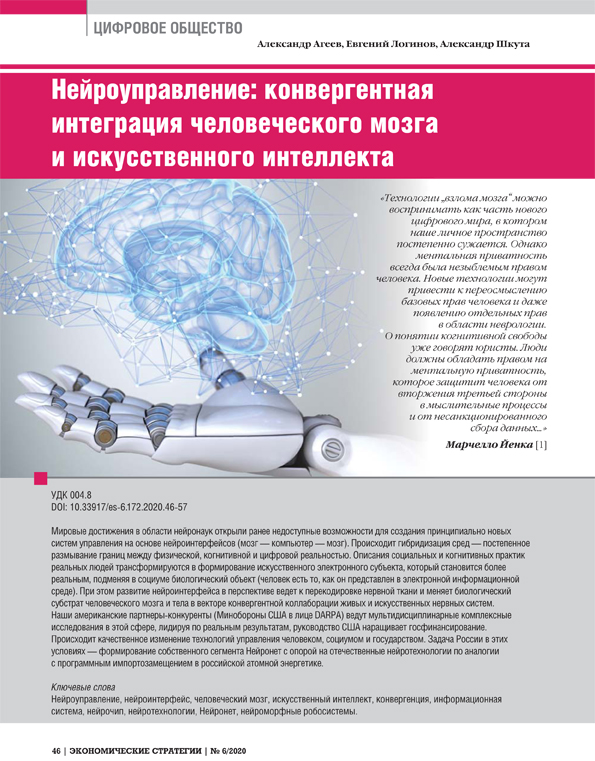Neuromanagement: Convergent Integration of the Human Brain and Artificial Intelligence
DOI: 10.33917/es-6.172.2020.46-57
World achievements in the field of neuroscience have provided previously inaccessible opportunities for creating fundamentally new control systems based on neurointerfaces (brain — computer — brain). Hybridization of environments — gradual blurring of the boundaries between physical, cognitive and digital realities — is taking place. Descriptions of social and cognitive practices of real people are transformed into forming an artificial electronic subject, which becomes more real, replacing a biological object in society (a person is how he is represented in the electronic information environment). At the same time, development of the neurointerface perspectively leads to conversion of nervous tissue and changes biological substrate of the human brain and body in the vector of convergent collaboration of living and artificial nervous systems. Our American competing partners (the US Department of Defence represented by DARPA) carry out multidisciplinary comprehensive research in this area, leading in real results, the US leadership is increasing government funding. A qualitative change in technologies for managing people, society and the state is taking place. Russia’s objective in these conditions is to form its own segment of Neuronet, relying on domestic neurotechnologies, by analogy with the policy of import substitution in Russian nuclear energy.
References:
1. Krasil’nikova Yu. Neirointerfeisy lishat lyudei kognitivnoi svobody [Neurointerfaces will Deprive People of Cognitive Freedom]. Khaitek, 2017, August, 15, available at: https://hightech.fm/2017/08/15/cognitive_liberty.
2. Ageev A.I., Loginov E.L. Rossiya v novoi ekonomicheskoi real’nosti [Russia in the New Economic Reality]. Moscow, INES, Assotsiatsiya “Analitika”, 2016, 460 p.
3. Ageev A.I., Loginov E.L. Bitva za budushchee: kto pervym v mire osvoit noomonitoring i kognitivnoe programmirovanie sub”ektivnoi real’nosti? [Battle for the Future: Who Will Be the First in the World to Master the Noomonitoring and Cognitive Programming of Subjective Reality?]. Ekonomicheskie strategii, 2017, no 2, pp. 124–139.
4. Loginov E.L., Eriashvili N.D., Bortalevich S.I., Loginova V.E. Tekhnologiya konstruirovaniya kachestv lichnosti na osnove imprintiruemykh refleksivnykh matrits [Technology for Designing Personality Qualities Based on Imprintable Reflective Matrices]. Vestnik Moskovskogo universiteta MVD Rossii, 2016, no 7, pp. 252–256.
5. Neirointerfeisy dlya servisov i produktov novogo pokoleniya [Neurointerfaces for Next-generation Services and Products]. Basisneuro, 2017, November, available at: https://basisneuro.com/BasisNeuroWhitePaper.pdf.
6. Publichnyi analiticheskii doklad po napravleniyu “Neirotekhnologii” [Public Analytical Report on Neurotechnology], available at: https://www.extech.ru/files/reports/neuroscience.pdf.
7. Neurogress: platforma sistem neiroupravleniya ot uchastnikov proekta BlueBrain [Neurogress: Platform of Neuromanagement Systems from the Project Participants]. ITnan, available at: https://itnan.ru/post.php?c=1&p=348498.
8. Loginov E.L., Loginova V.E., Shkuta A.A. “Dizain myshleniya” elementov iskusstvennogo intellekta dlya preodoleniya bar’erov polucheniya novogo znaniya v elektronnoi srede kollaboratsionnoi nauchnoi supersistemy [“Thinking Design” of Artificial Intelligence Elements for Overcoming Barriers to Obtaining New Knowledge in the Electronic Environment of Collaborative Scientific Super-System]. Iskusstvennye obshchestva, 2018, no 3, 5 p.
9. Ovod I.V., Osadchii A.E., Pupyshev A.A., Fradkov A.L. Formirovanie neiroobratnoi svyazi na osnove adaptivnoi modeli aktivnosti golovnogo mozga [Forming Neurofeedback Based on Adaptive Model of Brain Activity]. Neirokomp’yutery: razrabotka, primenenie, 2012, no 2, pp. 36–41.
10. Turovskii Ya.A., Kurgalin S.D., Adamenko A.A. Modelirovanie obucheniya neirochipov, vnedrennykh v nervnuyu tkan [Simulation of Training Neurochips Implanted in Nervous Tissue]. Tsifrovaya obrabotka signalov, 2016, no 1, pp. 50–56.
11. Galushkin A.I. Neirochipy i neiromorfnye EVM: problemy modelirovaniya [Neurochips and Neuromorphic Computers: Modeling Problems]. Informatsionnye tekhnologii, 2015, no 12, pp. 942–949.
12. Kalinin P.V., Voyutskaya Yu.Yu., Tarasov M.E. O primenenii neirointerfeisa dlya beskontaktnogo upravleniya mobil’nym ustroistvom [On Application of Neural Interface for Contactless Control of a Mobile Device]. Informatsionnye sistemy i tekhnologii, 2016, no 3, pp. 53–56.
13. Tychkov A.Yu., Goryachev N.V., Kochegarov I.I. Protokoly svyazi dlya besprovodnogo neirointerfeisa [Communication Protocols for Wireless Neurointerface]. Trudy mezhdunarodnogo simpoziuma “Nadezhnost’ i kachestvo” [Proceedings of the International Conference on Reliability and Quality]. Penza, Izd-vo Penzenskogo gosudarstvennogo universiteta, 2018, vol. 2, pp. 366–368.
14. DARPA profinansiruet sozdanie skorostnogo interfeisa mezhdu komp’yuterom i chelovecheskim mozgom [DARPA will Provide Funding for Creation of a High-speed Interface Between a Computer and the Human Brain]. Open Systems Publications, available at: https://www.osp.ru/news/2016/0126/13031430.
15. Raikov A.N. Konvergentnyi sintez kognitivnoi modeli na osnove glubokogo obucheniya i kvantovykh semantik [Convergent Synthesis of Cognitive Model Based on Deep Learning and Quantum Semantics]. International Journal of Open Information Technologies, 2018, vol. 6, no 12, pp. 43–50.
16. Tramp podpisal ukaz o razvitii II v SShA [Trump Signed a Decree on AI Development in the USA]. Khaitek, February, 12, available at: https://hightech.plus/2019/02/12/tramp-podpisal-ukaz-o-razvitii-ii-v-ssha.
17. DARPA finansiruet shest’ proektov po sozdaniyu interfeisa chelovek-komp’yuter [DARPA is Funding Six Projects for Creating Human-computer Interface]. AI-news, 2019, May, 24 maya, available at: http://ai-news.ru/2019/05/darpa_finansiruet_shest_proektov_po_sozdaniu_interfejsa_chelovek_komputer.html.
18. Pilot mozhet upravlyat’ 3 samoletami odnovremenno s neiroimplantom [A Pilot can Control 3 Aircraft Simultaneously with a Neuroimplant]. 24GADGET, available at: https://24gadget.ru/1161067418-pilot-mozhet-upravlyat-3-samoletami-odnovremenno-s-neyroimplantom.html.
19. DARPA ob”edinilo chelovecheskii mozg i 120-megapiksel’nye kamery, chtoby sozdat’ unikal’nuyu voennuyu sistemu obnaruzheniya ugrozy [DARPA has Combined a Human Brain and 120-megapixel Cameras to Create a Unique Military Threat Detection System]. PC Magazine, available at: https://blogs.pcmag.ru/node/1734.
20. Khizhnyak N. DARPA razrabatyvaet tekhnologiyu upravleniya voennymi dronami siloi mysli [DARPA is Developing Technology for Controlling Military Drones with the Power of Thought]. Hi-News, 2019, May, 22, available at: https://hi-news.ru/technology/darpa-razrabatyvaet-texnologiyu-upravleniya-voennymidronami-siloj-mysli.html.
21. DARPA razrabotalo sistemu dlya lecheniya neiropsikhiatricheskikh zabolevanii [DARPA has Developed a System for Treating Neuropsychiatric Diseases]. EverCare, 2018, December, 14, available at: https://evercare.ru/darpa-razrabotala-sistemu-dlya-lecheniya-neiropsik.
22. Khel’ I. 10 proektov DARPA, o kotorykh nuzhno znat’ vsem [10 DARPA Projects Everybody have to Know About]. Hi-News, 2015, September, 16, available at: https://hi-news.ru/technology/10-proektov-darpa-o-kotoryx-nuzhno-znat-vsem.html.
23. Gusach Yu.I., Bondar’ G.G. Selektsiya metok v failakh EDF dlya posleduyushchego analiza i sopostavleniya bioelektricheskoi aktivnosti na raznykh etapakh kognitivnoi deyatel’nosti [Marks Selection in EDF Files for Subsequent Analysis and Comparison of Bioelectric Activity at Different Stages of Cognitive Activity]. Rospatent RF. Svidetel’stvo o gosudarstvennoi registratsii programmy dlya EVM. N 2014610865 ot yanvarya 2014 g.
24. Loginov E.L., Raikov A.N., Shkuta A.A. Ispol’zovanie neirotekhnologii pri programmirovanii kognitivno-povedencheskikh stereotipov deistvii lichnostei dlya ustoichivogo funktsionirovaniya sistem upravleniya sotsiumom [Applying Neurotechnologies in Programming Cognitive-behavioral Stereotypes of Personality Actions for Stable Functioning of Social Management Systems]. Neirokomp’yutery: razrabotka, primenenie, 2018, no 9, pp. 34–45.
25. Shurkhai V.A., Aleksandrova E.V., Potapov A.A., Goryainov S.A. Sovremennoe sostoyanie problemy “interfeis mozg-komp’yuter” [Current State of the “Brain-computer Interface” Problem]. Voprosy neirokhirurgii im. N.N. Burdenko, 2015, vol. 79, no 1, pp. 97–104.
26. Esperazus E. Bioinzhenery predlagayut zamenyat’ glaza na sinteticheskie kiberimplanty [Bioengineers Suggest to Replace Eyes with Synthetic Cyber Implants]. Id.tech.biz, available at: http://idtech.biz/news/item.php?134758.
27. Podkhody k formirovaniyu i zapusku novykh otraslei promyshlennosti v kontekste Natsional’noi tekhnologicheskoi initsiativy na primere sfery “Tekhnologii i sistemy tsifrovoi real’nosti i perspektivnye “cheloveko-komp’yuternye” interfeisy (v chasti neiroelektroniki)” [Approaches to Development and Launch of New Industries in the Context of the National Technological Initiative on the Example of the Sphere “Technologies and Systems of Digital Reality and Promising
“Human-computer” Interfaces (in Terms of Neuroelectronics)”]. Analiticheskii doklad, available at: http://rusneuro.net/cambiodocs/media/files/analitijeskiidoklad-podhody-k-formirovaniu-i-zapusku-novyh-otraslei-promyhlennosti.pdf.
28. Kondur A.A. Prediktory effektivnosti neiroreabilitatsii patsientov s dvigatel’nymi narusheniyami s ispol’zovaniem neirointerfeisa mozg-komp’yuter [Efficiency Predictors for Neurorehabilitation of Patients with Movement Disorders Using the Brain-computer Interface]. Farmateka, 2017, no 19, pp. 72–77.
29. Frolov A.A., Aziatskaya G.A., Bobrov P.D. i dr. Elektrofiziologicheskaya aktivnost’ mozga pri upravlenii interfeisom mozg-komp’yuter, osnovannym na voobrazhenii dvizhenii [Electrophysiological Activity of the Brain in Managing the Brain-computer Interface Based on Movements Imagination]. Fiziologiya cheloveka, 2017, no 5, pp. 17–28.
30. Frolov A.A., Biryukova E.V., Bobrov P.D. i dr. Interfeis mozg — komp’yuter: fiziologicheskie predposylki i klinicheskoe primenenie [Brain-computer Interface: Physiological Prerequisites and Clinical Application]. Informatsionno-izmeritel’nye i upravlyayushchie sistemy, 2013, no 4, pp. 44–56.
31. Amitonova L.V., Anokhin K.V., Zheltikov A.M. i dr. Volokonno-opticheskii neirointerfeis i sposob dlya dolgovremennoi opticheskoi registratsii protsessov v mozge zhivykh svobodno dvizhushchikhsya zhivotnykh [Fiber-optic Neurointerface and Method for Long-term Optical Recording of Processes in the Brain of Living Freely Moving Animals]. Patent na izobretenie RUS 2637823 21.12.2015.
32. Smetanin N.M., Minkov V.A., Markina A.M., Osadchii E.A. Programmnoe obespechenie dlya sozdaniya, provedeniya i obrabotki eksperimentov v paradigm neiroobratnoi svyazi [Software for Creating, Conducting and Processing Experiments in the Neural Feedback Paradigm]. Sb. materialov III Mezhdunarodnoi konferentsii “Neirokomp’yuternyi interfeis: nauka i praktika. Samara, 2017 [Materials of the III International Conference “Neurocomputer Interface: Science and Practice”m Samara, 2017]. Samara, Samarskii gosudarstvennyi meditsinskii universitet, 2017, pp. 53–54
33. Shepelev I.E., Lazurenko D.M., Kiroi V.N. i dr. Novyi neirosetevoi podkhod k sozdaniyu IMK na osnove EEG-patternov proizvol’nykh myslennykh dvizhenii [New Neural Network Approach to Creating BCI Based on EEG Patterns of Voluntary Mental Movements]. Zhurnal vysshei nervnoi deyatel’nosti im. I.P. Pavlova, 2017, no 4, pp. 527–545.
34. Shepelev I.E. Programma realizatsii neiroobratnoi svyazi na osnove chastotnykh kharakteristik EEG-signala [Neurofeedback Implementation Program Based on the Frequency Characteristics of EEG Signal]. Svidetel’stvo o gosudarstvennoi registratsii programmy dlya EVM N 2013617088 ot 4 oktyabrya 2013 g.
35. Tsareva G. Neironet [NeuroNet]. Monomakh, 2018, August, 29, available at: http://monomah.org/archives/12047.
36. Annotatsiya k planu meropriyatii (“dorozhnoi karte”) po razvitiyu rynka NeiroNet Natsional’noi tekhnologicheskoi initsiativy [Abstract of the Action Plan (Roadmap) for Developing the NeuroNet Market of the National Technological Initiative]. DocPlayer, available at: https://docplayer.ru/32735454-
Annotaciya-k-planu-meropriyatiy-dorozhnoy-karte-po-razvitiyu-rynka-neyronet-nacionalnoy-tehnologicheskoy-iniciativy.html
37. Chaivanov D.B., Chudina Yu.A. Primenenie tekhnologii neiromodulyatsii dlya upravleniya psikhofunktsional’nym sostoyaniem i kognitivnymi strategiyami cheloveka [Applying Neuromodulation Technologies to Manage Psycho-functional State and Cognitive Strategies of a Person]. Vestnik Rossiiskogo universiteta druzhby narodov, 2011, no 2, pp. 32–38. (Seriya: Psikhologiya i pedagogika.)
38. Ageev A.I., Loginov E.L., Shkuta A.A. Konvergentnyi monitoring i programmirovanie lichnosti kak instrument operirovaniya intellektual’noi dinamikoi povedeniya bol’shikh grupp lyudei [Convergent Monitoring and Programming of Personality as a Tool for Managing Intellectual Dynamics of Behavioral Activity of Large Groups of People]. Ekonomicheskie strategii, 2018, no 2, pp. 70–87.
39. Internet-serfing menyaet mozg pol’zovatelya [Internet Surfing Changes the User’s Brain]. SecurityLab, 2010, August, 30, available at: https://www.securitylab.ru/news/397247.php.



